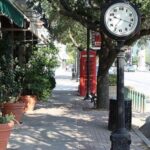The State tree of Georgia is the Southern Live Oak (Quercus virginiana). The trees are also known as live oak, Virginia live oak, West Texas live oak, and scrub live oak. These trees can be found growing in the wild in Alabama, Arizona, Florida, Georgia, Kentucky, Louisiana, Mississippi, Oklahoma, North Carolina, South Carolina, Tennessee, Texas, and Virginia. The live oaks are hardy in Zones 7B to 10B.
Live oak trees drop their leaves in the spring as new growth is emerging which makes the tree somewhat deciduous and somewhat evergreen. The leaves remain green in color throughout the year. When planted in open areas, the trees can reach a mature height of 50 feet, with trunks 3-4 feet across, and canopies of up to 150 feet. The trees are often seen draped in Spanish moss. It is not uncommon to find live oak trees that are hundreds of years old.
The live oaks grow quickly if planted in rich soil and watered regularly. The trees prefer well drained soils with incorporated sand. They are not harmed by flooding if the water drains quickly. They are resistant to damage from salt spray. The live oaks grow in both sunny and partially shady situations.
Small brown flowers appear in the spring, and produce acorns that drop to the ground in the early winter. The trees and dropped leaves hold moisture and are resistant to fires. The roots have been known to regenerate growth after heavy fire damage.
The live oak is not widely used on a commercial basis. The trees are planted for shade in residential and park landscapes. The trees are also used for reforestation projects in areas previously cleared for agricultural production. The expansive canopy of the live oak is a recognized symbol for the Old Southern.
In the days of wooden ship building, live oak trees were used extensively. Today the trees are planted in parking lot islands, on streets with wide extensions, along highways, and in large landscape areas. If planted in residential areas, routine maintenance is needed to clear the ground litter of acorns, twigs, and leaves.
Pruning may be necessary along streets and walkways since the heavy wood will drag the branches to the ground as the tree ages. Surface roots can also be a problem as they are known to lift sidewalks, curbs, and driveways. Professional trimming is recommended for young trees to assure a pleasant and healthy shape and branching habit.
The acorns produced in the fall are a food source for bobwhite, Florida scrub jay, mallard, sapsuckers, wild turkey, black bear, squirrels, and white-tailed deer. The tree canopy is a nesting habitat for several bird species including scrub jay, hooded oriole, pygmy-owl, red-billed pigeon, northern beardless tyrannulet (flycatcher), and Couch’s kingbird. The scrub jay is considered a threatened species in Florida.
The live oak has predators. A wilt disease is attacking forests in Texas. Leaf blister, gall wasps, and borers negatively affect the live oaks. The trees are also susceptible to hard freezing. The life oaks survive urban air pollution, less than ideal drainage area, and compacted soils.
Sources
Quercus virginiana, USDA Forest Service, http://www.fs.fed.us/database/feis/plants/tree/quevir/all.html
Quercus virginiana, University of Florida, http://hort.ufl.edu/trees/QUEVIRA.pdf
Quercus virginiana, University of Arizona Pima County Cooperative Extension, http://ag.arizona.edu/pima/gardening/aridplants/Quercus_virginiana.html
Quercus virginiana, USDA Natural Resources Conservation Services, http://www.ces.ncsu.edu/depts/hort/consumer/factsheets/trees-new/quercus_virginiana.html
Trail Marker Trees, University of Illinois Extension, http://web.extension.uiuc.edu/illinoissteward/openarticle.cfm?ArticleID=26&Page;=2





